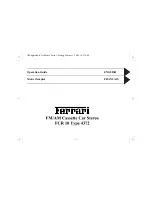
Wireless Notices
In some environments, the use of wireless devices may be restricted. Such restrictions may apply aboard
airplanes, in hospitals, near explosives, in hazardous locations, etc. If you are uncertain of the policy
that applies to the use of this device, please ask for authorization to use it prior to turning it on.
U.S. Regulatory Wireless Notice
WARNING!
Exposure to Radio Frequency (RF) Radiation The radiated output power of this
device is far below the FCC radio frequency exposure limits. Nevertheless, users concerned with
the risk of Radio Frequency exposure may want to limit the duration of calls and position the
antenna as far away from the body as practical. For body worn operation, this device has been
tested and meets the FCC RF exposure guidelines when used with the Hewlett-Packard
accessories supplied with or designated for this product. Use of other accessories may not ensure
compliance with FCC RF exposure guidelines.
U.S. Regulatory Notice For 900/1800 GSM Frequency Bands
This device contains 900/1800 MHz GSM functions that are not operational in U.S. territories. This filing
is only applicable for GSM 850 MHz and PCS 1900 MHz operations.
Health and Safety Information
Since your HP wireless phone is a radio transmitter and receiver, you may be exposed to Radio
Frequency (RF) signals when it is powered on. However, your HP wireless phone has been designed
so that it does not exceed the emission limits for exposure to radio frequency energy that are set by the
Federal Communications Commission of the U.S. Government. These limits are part of comprehensive
guidelines and establish permitted levels of RF energy for the general population. The guidelines are
based on the safety standards previously set by both the United States and international standards.
This equipment under test has been shown to be capable of compliance for localized Specific Absorption
Rate (SAR) for uncontrolled environment/general population exposure limits specified in ANSI/IEEE
Standard C95.1-1992 and had been tested in accordance with measurement procedures specified in
FCC/OET Bulletin 65 Supplement C (2001) and IEEE Standard 1528-200X (Draft 6.5, January 2002).
Ministry of Health (Canada), Safety Code 6. The standards include a substantial safety margin designed
to assure the safety of all persons, regardless of age and health. The exposure standard for wireless
mobile phones employs a unit of measure known as the Specific Absorption Rate (SAR). The SAR limit
set by the FCC is 1.6W/kg.
NOTE
In the U.S. and Canada, the SAR limit for mobile phones used by the public is 1.6 watts/
kg (W/kg) averaged over one gram of tissue. The standard incorporates a substantial margin of
safety to give additional protection to the public and to account for any variations.
Canadian Regulatory Wireless Notice
Operation is subject to the following two conditions: (1) this device may not cause interference, and (2)
this device must accept any interference, including interference that may cause undesired operation of
the device.
ENWW
Wireless Notices
191
Summary of Contents for iPAQ
Page 1: ...Additional Product Information User Guide ...
Page 9: ...1 Registering the iPAQ ENWW 1 ...
Page 11: ...2 Phone ENWW 3 ...
Page 39: ...3 Connections ENWW 31 ...
Page 66: ...4 Global Positioning System GPS 58 Chapter 4 Global Positioning System GPS ENWW ...
Page 78: ...5 Security 70 Chapter 5 Security ENWW ...
Page 86: ...6 Camera select models only 78 Chapter 6 Camera select models only ENWW ...
Page 92: ...7 HP Photosmart Mobile 84 Chapter 7 HP Photosmart Mobile ENWW ...
Page 97: ...8 HP Photosmart Premier ENWW 89 ...
Page 100: ...9 HP Image Transfer 92 Chapter 9 HP Image Transfer ENWW ...
Page 103: ...10 Messaging ENWW 95 ...
Page 116: ...11 Java MIDlet Manager 108 Chapter 11 Java MIDlet Manager ENWW ...
Page 119: ...12 Learning The Basics ENWW 111 ...
Page 135: ...13 Calendar ENWW 127 ...
Page 141: ...14 Contacts ENWW 133 ...
Page 151: ...15 Entering Text ENWW 143 ...
Page 157: ...16 Notes ENWW 149 ...
Page 161: ...17 Expansion Cards ENWW 153 ...
Page 166: ...18 Synchronizing 158 Chapter 18 Synchronizing ENWW ...
Page 170: ...19 Tasks 162 Chapter 19 Tasks ENWW ...
Page 175: ...20 Product Specifications ENWW 167 ...
Page 181: ...21 Microsoft Programs ENWW 173 ...
Page 188: ...22 Regulatory Notices 180 Chapter 22 Regulatory Notices ENWW ...
Page 204: ......






































